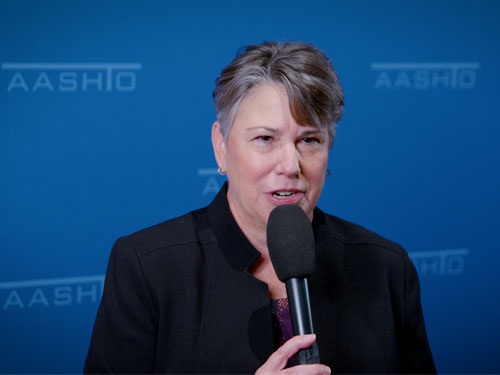The American Association of State Highway and Transportation Officials recently hosted a knowledge session at its 2023 Spring Meeting in Seattle that delved into ways transportation agencies can get the most out of the discretionary grant programs funded by the $1.2 trillion Infrastructure Investment and Jobs Act or IIJA enacted in November 2021.
[Above photo by AASHTO]
Aimee Flannery, global technology leader-transportation risk and resiliency for Jacobs – which sponsored the knowledge session – noted that the AASHTO board of directors directed the organization’s Transportation Policy Forum in 2022 to create a “working group” aimed at making the federal transportation discretionary grant process less cumbersome and more transparent for state and local applicants alike.
Keith Benjamin, who serves as associate administrator for highway policy and external affairs for the Federal Highway Administration and one of the session’s panelists, shared his own personal experience with the federal transportation grant application process from his time as director of the Department of Traffic and Transportation for the city of Charleston, SC.
“The cost of grant applications is a real thing,” he explained. “It cost us $220,000 to do a grant application [for a bridge project] and I had to convince the city council to provide funds for a grant we were not sure we’d win. So it’s a lift. And if you miss a small piece, you can be put back at square one.”
That’s where he said state departments of transportation can play a key role, especially in terms of partnering with localities to craft and support grant applications for key infrastructure projects.
“Partnerships are imperative for me,” he said. “At Charleston, when we sought a grant to build a critical piece of infrastructure – a bridge linking neighborhoods to our medical district – Christy Hall [secretary of the South Carolina Department of Transportation] called me and said, ‘this is important; we’re going to help you get a grant for this project.’ Because a community is a community – red or blue, they have needs: economic needs, safety needs, etc. So the narrative is, the project is important to the community, so you need partnerships to support that narrative.”
Benjamin stressed, however, that projects slated for grant applications “have to be good projects backed by good applications.” He added, too, that “it matters” when FHWA receives letters of support from Congressional members, local charities, churches, etc., about the needs an infrastructure project can fulfill. “It’s a mark as to the importance of a project,” he said.
Harriet Tregoning – director-new urban mobility alliance for the WRI Ross Center for Sustainable Cities who served in the Department of Housing and Urban Development during President Obama’s administration – also emphasized the importance of partnerships when it comes to applying for discretionary grants.
“There is no point in doing a plan without state DOTs, businesses, and communities at the table,” she said. “State DOTs can help by being intermediaries for federal funds to support many smaller local projects. They can help local communities do the zoning and the planning work, to make infrastructure projects if not shovel ready at least shovel worthy for grant funding.”
Tregoning stressed that community engagement and trust are critical for state DOTs in these local partnerships. “How you start is a big deal – you need to build good will and not be transactional,” she said. “Also, look for common needs, such as sidewalks and bike/pedestrian infrastructure. There is a lot of money out there [from the IIJA] so do what you have the imagination to do. You [state DOTs] are all about access; that is the most important role on the planet, because it is central to everything – the provision of access, mobility, and safety.”
Dawn Sullivan, deputy director of the Oklahoma Department of Transportation, touched on a key benefit to state DOTs in this grant partnership effort with local communities: Grants free up money so state DOTs can move forward other infrastructure projects.
“We do not have a funding mechanism at the state level for eliminating railroad crossings – that’s why the FRA [Federal Railroad Administration] grant program is so important; it is providing that funding,” she said.
Sullivan added that partnering with local communities for project grants helps prevent “surprises” for state DOTs as well.
“Small towns don’t have the professional capacity to manage USDOT funding software – and they have no cash flow mechanism to distribute [grant] funds,” she explained. “That’s why we need to be involved in the planning of things, instead of being surprised when they come to us for help after the grant is won.”
Joel Jundt, secretary of the South Dakota Department of Transportation, added that gaining opportunities to “pre-review” transportation project grant applications is another benefit of coordination between state DOTs with local governments.
“That pre-qualification process helps determine project eligibility and also allows us to make sure the application meets all requirements, such as meeting NEPA [National Environmental Policy Act] requirements,” he said. “It is also an opportunity to demonstrate that applicants can supply the matching funding for the grant as well as determine the capacity of the applicant to administer and deliver the project.”
Jundt noted that there is currently a National Cooperative Highway Research Program study underway – “the panel has its first meeting in a few months,” he said – that seeks to create guidelines for state DOTs on how to collaborate and coordinate with local governments on grant applications.
“The education of local governments on where to start with grant applications is during the project planning phase, not at the construction phase,” he stressed. “It always goes back to relationships between state DOTs and local communities and understanding the needs that will be met with a particular transportation project.”
 Top Stories
Top Stories
USDOT Makes $1.5B Worth of BUILD Grants Available
December 19, 2025 Top Stories
Top Stories

